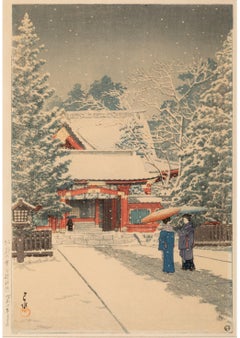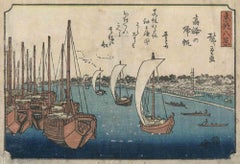Watanabe Nobukazu Art
to
1
Overall Width
to
Overall Height
to
1
1
1
1
1
1
1
1
10,138
2,779
1,375
1,369
1
Artist: Watanabe Nobukazu
The Second Army Bombarding, Ukiyo-E Wooblock by Watanabe Nobukazu
By Watanabe Nobukazu
Located in Long Island City, NY
Artist: Watanabe Nobukazu, Japanese (1872 - 1944)
Title: The Second Army Bombarding and Occupying Port Arthur
Year: 1894
Medium: Woodblock Triptych...
Category
1890s Other Art Style Watanabe Nobukazu Art
Materials
Woodcut
Related Items
Kawase Hasui -- Snow at Hie Shrine, circa 1946 - 1957
By Kawase Hasui
Located in BRUCE, ACT
Kawase Hasui (Japanese, 1883-1957)
Snow at Hie Shrine, circa 1946 -1957 (dated in the publisher's seal)
Woodblock
Sheet size 37.5 x 26.0 cm (vertical oban)
Frame size 51.3 x 38.5 x 2...
Category
1940s Watanabe Nobukazu Art
Materials
Woodcut
$4,823 Sale Price
30% Off
H 14.77 in W 10.24 in
Takanawa no Kihan - Woodblock print by Utagawa Hiroshige - 1843-1847
By Utagawa Hiroshige
Located in Roma, IT
Takanawa no kihan is a modern artwork realized between 1843 and 1847 after Utagawa Hiroshige.
Ukiyo-e color woodblock print from the Touto hakkei (The Eight Famous Views of the Capital of the East) series.
Mounted under passepartout.
The artwork depicts the port of Takanawa, a suburb of Minato in southern Tokyo, and is one of the very rare sheets by Utagawa Ando Hiroshige...
Category
Mid-19th Century Modern Watanabe Nobukazu Art
Materials
Woodcut
$780
H 6.93 in W 9.61 in D 0.04 in
Parade - Woodblock Print by Utagawa Kunisada - Mid-19th Century
By Utagawa Kunisada (Toyokuni III)
Located in Roma, IT
Celebratory Parade is an original Woodcut print realized in mid 19th century after Utagawa Kunisada.
Good condition and Beautiful colored woodblock print.
This wonderful modern a...
Category
Mid-19th Century Modern Watanabe Nobukazu Art
Materials
Woodcut
$540
H 14.38 in W 9.85 in D 0.04 in
Hiroshige (1797-1858) - View of Kasumigaseki (Kasumigaseki no zu) 東都名所
By Utagawa Hiroshige (Ando Hiroshige)
Located in BRUCE, ACT
Artist: 広重 Hiroshige (1797-1858)
Series: Famous Places in the Eastern Capital (Tôto meisho) (東都名所)
Title: View of Kasumigaseki (Kasumigaseki no zu) 霞がせきの図
Size: O-ban 大判 24.2 x 36...
Category
1840s Watanabe Nobukazu Art
Materials
Woodcut
The Ferry at Sakasai - One Hundred Famous Views of EDO 名所江戸百景
By Utagawa Hiroshige (Ando Hiroshige)
Located in BRUCE, ACT
Hiroshige (1797-1858) - One Hundred Famous Views of EDO 名所江戸百景
Artist: 広重 Hiroshige (1797-1858)
Series: One Hundred Famous Views of EDO (名所江戸百景)
Title: The Ferry at Sakasai (逆井のわたし...
Category
1850s Watanabe Nobukazu Art
Materials
Woodcut
$2,704 Sale Price
20% Off
H 14.18 in W 9.45 in
Elwood W. Bartlett, Wisconsin Farm, about 1945, mid-century wood engraving
Located in New York, NY
Elwood Warren Bartlett is a Wisconsin native who also worked in Indiana.
Largely self taught as a printmaker, Bartlett worked in a style that once identified as his, immediately t...
Category
1940s American Modern Watanabe Nobukazu Art
Materials
Woodcut
'Hill' — American Modernism, California
By Paul Landacre
Located in Myrtle Beach, SC
Paul Landacre, 'Hill', wood engraving, 1936, edition 60 (only 54 printed); only 2 impressions printed in a second edition of 150. Signed, titled, and numbered '49/60' in pencil. Wien...
Category
1930s American Modern Watanabe Nobukazu Art
Materials
Woodcut
Yoshida Hiroshi -- The Golden Pavilion 金阁
By Yoshida Hiroshi
Located in BRUCE, ACT
Title "The Golden Pavilion" 金阁
Date 1933; (posthumous edition, likely 1950's/60's).
Publisher Yoshida Family Studio
Image Size 9 5/8 x 14 3/4
Impression Very Fine. Sk...
Category
Early 20th Century Watanabe Nobukazu Art
Materials
Woodcut
Matsubaya - Woodblock Print by Utagawa Kuniyoshi - Mid-19th Cent.
By Utagawa Kuniyoshi
Located in Roma, IT
Yosooi of the Matsubaya is an Original Woodcut Print, Oban Format, realized by Kitagawa Tsukimaro.
Good condition but many folds in the paper.
No signature.
Kitagawa Tsukimaro ( 1...
Category
Mid-19th Century Modern Watanabe Nobukazu Art
Materials
Woodcut
$552
H 14.18 in W 9.65 in D 0.04 in
Kawase Hasui -- Rain at Yasuniwa (Nagano)
By Kawase Hasui
Located in BRUCE, ACT
Kawase Hasui
Rain at Yasuniwa (Nagano), 1946
woodcut in colours
Signed on the block, sealed, titled and dated in ink
Publisher: Shozaburo Watanabe, with his 6mm seal
The first state
...
Category
1940s Watanabe Nobukazu Art
Materials
Woodcut
$3,168 Sale Price
20% Off
H 10.32 in W 14.38 in
Hiroshige (1797-1858) - Ueno Yamashita
By Utagawa Hiroshige (Ando Hiroshige)
Located in BRUCE, ACT
Artist: Utagawa Hiroshige (Hiroshige Ando 1797-1858)
Title: No.12 Ueno Yamashita
Series: One Hundred Famous Views of Edo (名所江戸百景)
Size: O-ban 大判
Age: 1858
Category
1850s Watanabe Nobukazu Art
Materials
Woodcut
$3,710 Sale Price
30% Off
H 13.98 in W 9.45 in
Hiroshige (1797-1858) - Horie and Nekozane - Meisho Edo Hyakkei
By Utagawa Hiroshige (Ando Hiroshige)
Located in BRUCE, ACT
Artist: Utagawa Hiroshige (Hiroshige Ando 1797-1858)
Title: No.96 "Meisho Edo Hyakkei"
Series: One Hundred Famous Views of Edo (名所江戸百景)
Size: O-ban 大判
Age: 1856
Category
1850s Watanabe Nobukazu Art
Materials
Woodcut
$3,840 Sale Price
20% Off
H 13.98 in W 9.3 in
Watanabe Nobukazu art for sale on 1stDibs.
Find a wide variety of authentic Watanabe Nobukazu art available for sale on 1stDibs. You can also browse by medium to find art by Watanabe Nobukazu in woodcut print and more. Not every interior allows for large Watanabe Nobukazu art, so small editions measuring 28 inches across are available. Customers who are interested in this artist might also find the work of Utagawa Hiroshige (Ando Hiroshige), Utagawa Yoshitora, and Henri Riviere. Watanabe Nobukazu art prices can differ depending upon medium, time period and other attributes. On 1stDibs, the price for these items starts at $2,500 and tops out at $2,500, while the average work can sell for $2,500.

